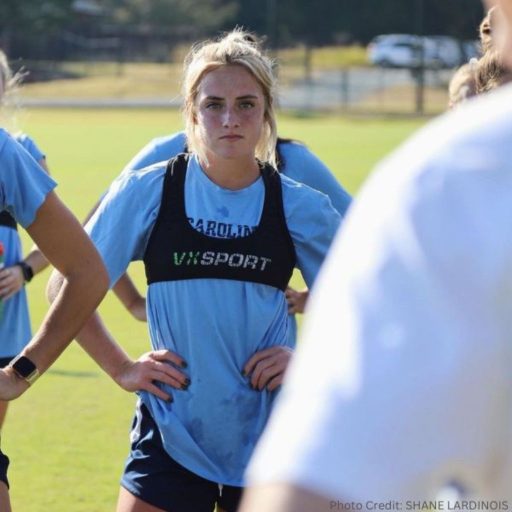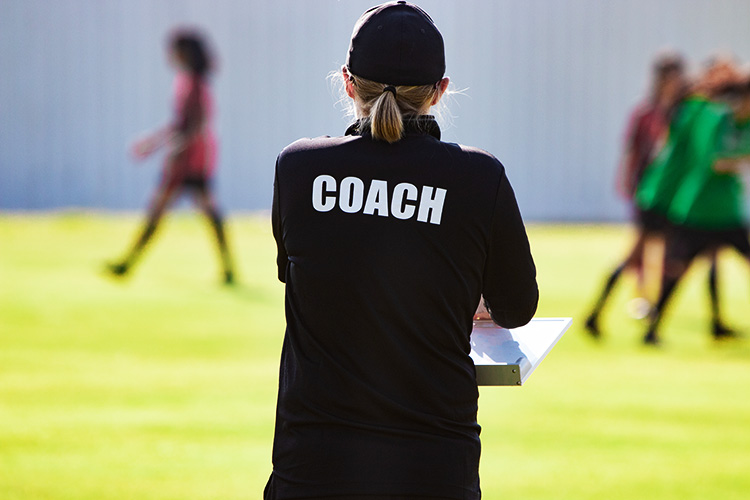Measuring Soccer Performance with Physical Tests
Understanding the Key Physical Tests for Female Soccer Players
From Speed to Strength
Physical Measurements' Role
Physical measurements play a significant role in the comprehensive evaluation of women soccer players. Coaches recognize the importance of assessing key physical attributes as part of the overall assessment process.
These measurements, including speed, endurance, agility, and strength, provide valuable insights into a player’s athletic capabilities and potential contributions on the field. While physical measurements are just one piece of the puzzle, they serve as benchmarks that help coaches assess a player’s potential impact and suitability for different positions and playing styles.
By considering these measurements alongside other factors such as technical skills, tactical awareness, and mental aptitude, coaches can form a well-rounded evaluation to guide their player selections and development strategies.

Table of Contents
Speed and Acceleration
- 40-Yard Dash: The 40-yard dash is a popular test used to measure an athlete’s straight-line speed and acceleration. Players sprint for a distance of 40 yards (36.6 meters) as quickly as possible, and their time is recorded. Faster times indicate superior speed and acceleration, which are valuable attributes on the soccer field, especially when making quick sprints or chasing down opponents.
- Benchmark: Division I: Sub 5.0 seconds
- Benchmark: Division II: Sub 5.2 seconds
- Benchmark: Division III: Sub 5.4 seconds
- 30-Meter Sprint: Similar to the 40-yard dash, the 30-meter sprint focuses on measuring acceleration and short-distance speed. Athletes sprint for 30 meters, and their time is recorded. This test provides a more concise measure of explosive bursts and initial acceleration.
- Benchmark for Division I: Sub 4.0 seconds
- Benchmark for Division II: Sub 4.2 seconds
- Benchmark for Division III: Sub 4.4 seconds
- Flying Sprints: This test involves timed sprints over a specified distance, typically 20-30 meters, with a running start. It assesses a player’s ability to accelerate quickly and reach their top speed.
- Benchmark for Division I: Sub 3.0 seconds
- Benchmark for Division II: Sub 3.1 seconds
- Benchmark for Division III: Sub 3.2 seconds
- 10-meter acceleration test: This test measures a player’s ability to accelerate quickly over a short distance. It focuses on explosive bursts of speed, which are crucial for various soccer actions such as sprinting to beat opponents, chasing down loose balls, or making quick changes of direction. During the test, the player starts from a stationary position and sprints as fast as possible for a distance of 10 meters. The time taken to cover this distance is recorded to evaluate the player’s acceleration and initial burst of speed.
- Benchmark for Division I: Sub 1.8 seconds
- Benchmark for Division II: Sub 1.9 seconds
- Benchmark for Division III: Sub 2.0 seconds
- 5/10/20-Meter Sprint: These shorter distance sprints focus on measuring acceleration and speed relevant to soccer movements. Players sprint for 5, 10, or 20 meters, and their times are recorded. These tests assess quick bursts of speed, which are valuable for short sprints during gameplay or beating opponents to the ball. The following are the Benchmarks for :
- Division I: Sub 1.0 seconds (5m), Sub 1.8 seconds (10m), Sub 3.6 seconds (20m)
- Division II: Sub 1.1 seconds (5m), Sub 1.9 seconds (10m), Sub 3.7 seconds (20m)
- Division III: Sub 1.2 seconds (5m), Sub 2.0 seconds (10m), Sub 3.8 seconds (20m)

These benchmarks indicate the desired level of acceleration for players aiming to compete at each respective division level. It’s important to note that these benchmarks should be considered general guidelines, and specific programs may have slightly different expectations based on their playing style, position requirements, and other factors.
Explosiveness and Power
- Vertical Jump: The vertical jump test assesses an athlete’s lower-body explosive power. Players jump vertically as high as possible, and the height reached is measured. A higher vertical jump indicates greater lower-body power, which can be advantageous for aerial challenges, leaping for headers, and explosive movements such as shooting and changing direction quickly.
- Benchmark for Division I: 18-20+ inches
- Benchmark for Division II: 16-18 inches
- Benchmark for Division III: 14-16 inches
- Standing Broad Jump: The standing broad jump evaluates horizontal power and explosiveness. Athletes jump forward from standing, and the distance covered is measured. This test measures a player’s ability to generate power from a static position, which can be beneficial for actions like leaping forward for interceptions or lunging into tackles.
- Benchmark for Division I: 7-8+ feet
- Benchmark for Division II: 6.5-7 feet
- Benchmark for Division III: 6-6.5 feet
- Medicine Ball Throws: This test assesses upper-body power and explosiveness. Players perform various throwing exercises with a medicine ball, such as overhead throws or chest passes. The distance or height achieved with the throws is measured to evaluate power output.
- Benchmark for Division I: 18-20+ feet
- Benchmark for Division II: 16-18 feet
- Benchmark for Division III: 14-16 feet
Test results matter, but coaches and scouts consider more than just physical performance. Technical skills, tactics, game intelligence, physical attributes, and teamwork also factor into player evaluation and selection.

Agility and Quickness
- Shuttle Run: The shuttle run measures a player’s agility and ability to change direction quickly. It involves sprinting back and forth between two markers placed a specific distance apart. The time taken to complete the shuttle run is recorded.
- Benchmark for Division I: Sub 10.0 seconds
- Benchmark for Division II: Sub 10.5 seconds
- Benchmark for Division III: Sub 11.0 seconds
- Lateral Agility Test: Evaluates a player’s side-to-side movement, quickness, and agility. Players shuffle laterally between cones or markers as quickly as possible, and their times are recorded.
- Benchmark for Division I: Sub 12.0 seconds
- Benchmark for Division II: Sub 13.0 seconds
- Benchmark for Division III: Sub 14.0 seconds
- T-Test: The T-Test measures agility, cutting ability, and quickness. Players start at the center of a T-shaped course and perform forward sprints, lateral shuffles, and backward running. The time taken to complete the course is recorded. A faster time indicates better agility and quickness, particularly in movements involving changes of direction.
- Benchmark for Division I: Sub 8.0 seconds
- Benchmark for Division II: Sub 8.5 seconds
- Benchmark for Division III: Sub 9.0 seconds
- Illinois Agility Test: The Illinois Agility Test is a common test to assess agility, change of direction, and quickness. Players navigate an agility course that includes forward running, lateral shuffling, backpedaling, and quick changes of direction. The time taken to complete the course is recorded, with faster times indicating better agility and quickness, which are essential for evading opponents, changing direction during dribbling, and defensive movements.
- Benchmark for Division I: Sub 16.0 seconds
- Benchmark for Division II: Sub 17.0 seconds
- Benchmark for Division III: Sub 18.0 seconds
- Lateral Agility Test: This test evaluates side-to-side quickness and agility, which are important for rapid changes of direction and defensive movements. Players shuffle laterally between cones or markers as quickly as possible, and their times are recorded.
- Benchmark for Division I: Sub 12.0 seconds
- Benchmark for Division II: Sub 13.0 seconds
- Benchmark for Division III: Sub 14.0 seconds
Test results matter, but coaches and scouts consider more than just physical performance. Technical skills, tactics, game intelligence, physical attributes, and teamwork also factor into player evaluation and selection.
Endurance and Aerobic Capacity
- Yo-Yo Intermittent Recovery Test (Beep Test): The Yo-Yo Intermittent Recovery Test, also known as the Beep Test, is a popular test to assess aerobic capacity and endurance. Players run back and forth between two lines, timed to audio beeps. The time between beeps gradually decreases, requiring players to maintain a high level of running intensity for as long as possible. The level and distance achieved before exhaustion are recorded.
- Benchmark for Division I: Level 13+
- Benchmark for Division II: Level 11-12
- Benchmark for Division III: Level 9-10+
- Cooper Test: The Cooper Test measures an athlete’s running endurance over a 12-minute period. Players run as far as they can within the allotted time, and the distance covered is recorded. Greater distances indicate better aerobic endurance, crucial for maintaining performance throughout a match and effectively covering a large playing area.
- Benchmark for Division I: 8202+ feet or 2500+ meters
- Benchmark for Division II: 7218-8202 feet or 2200-2500 meters
- Benchmark for Division III: 6562-7218 feet or 2000-2200 meters
- Interval Runs: Interval running tests involve a series of timed runs at different intensities, simulating the intermittent nature of soccer. These tests measure a player’s ability to sustain effort and recover quickly during game-like scenarios.
- Benchmark for Division I: Distance covered 3937 feet or 1200+ meters
- Benchmark for Division II: Distance covered 1000-1200 meters
- Benchmark for Division III: Distance covered 800-1000 meters
- 30-15 Intermittent Fitness Test: These tests aim to mimic the intermittent nature of soccer, combining running and recovery periods. The 30-15 Intermittent Fitness Test involves running between two lines, timed to beeps, with varying intensities and short recovery periods. The distance covered and the level achieved indicate an athlete’s ability to sustain performance during repeated bursts of effort, similar to the demands of a soccer match.
Test results matter, but coaches and scouts consider more than just physical performance. Technical skills, tactics, game intelligence, physical attributes, and teamwork also factor into player evaluation and selection.

Physical Strength and Endurance Circuit
Physical Strength and Endurance Circuit are less common at a tryout. It’s a comprehensive series of stations or exercises designed to assess a female soccer player’s muscular strength, endurance, and overall fitness. Here are some examples of exercises commonly included in a Physical Strength and Endurance Circuit for women soccer players:
- Push-ups: This exercise primarily targets the chest, triceps, and shoulders while also engaging the core muscles. It evaluates upper body strength and endurance, which are important for actions like shielding opponents and winning aerial duels. The push-up test is a measure of upper body strength and endurance commonly used in soccer evaluations. The player starts in a prone position with hands shoulder-width apart and performs a series of consecutive push-ups, maintaining proper form and full range of motion.
- Benchmark for Division I: 25-30 push-ups
- Benchmark for Division II: 20-25 push-ups
- Benchmark for Division III: 15-20 push-ups
-
Sit-ups: Sit-ups focus on strengthening the abdominal muscles and core. It assesses core strength and endurance, which are crucial for stability, balance, and generating power during movements like shooting, passing, and changing direction. The player lies on their back with knees bent, feet flat on the ground, and hands crossed over the chest. They then perform a series of consecutive sit-ups, raising their upper body until their elbows touch their thighs and then lowering back down to the starting position.
-
Benchmark for Division I: 35-40 sit-ups in one minute,
-
Benchmark for Division II: 30-35 sit-ups in one minute
-
Benchmark for Division III: 25-30 sit-ups in one minute
-
-
Planks: Planks are an isometric exercise that engages the core muscles, including the abs, back, and glutes. It tests-core stability and endurance, which play a vital role in maintaining body control, balance, and resisting fatigue during the game. The player assumes a push-up position, supporting their body weight on their forearms and toes, while maintaining a straight line from head to toe. The goal is to hold the plank position for as long as possible without letting the hips sag, or the body lose alignment.
-
Benchmark for Division I: 2-3 minutes
-
Benchmark for Division II: 1.5-2.5 minutes
-
Benchmark for Division III: 1-2 minutes.
-
-
Lunges: Lunges target the lower body, particularly the quadriceps, hamstrings, and glutes. They assess leg strength, stability, and muscular endurance, which are crucial for actions like acceleration, deceleration, and maintaining balance during changes of direction. In this test, the player takes a step forward with one leg and lowers their body until the front knee is bent at a 90-degree angle while keeping the back knee just above the ground, then returns to standing and repeats the movement with the opposite leg.
-
Benchmark for Division I: 20-25 lunges per leg in one minute
-
Benchmark for Division II: 15-20 lunges per leg in one minute
-
Benchmark for Division III: 10-15 lunges per leg in one minute
-
-
Box Jumps: Box jumps involve jumping onto a box or platform from a standing position. They evaluate lower-body explosive power, coordination, and reactive strength, which are valuable for actions like leaping for headers and quickly changing direction during gameplay. In this test, the player starts in a standing position and jumps onto a designated box or platform with both feet, ensuring a full extension of the hips and knees at the top of the jump.
-
Benchmark for Division I: Box heights from 24 to 30 inches
-
Benchmark for Division II: Box heights from 20 to 24 inches
-
Benchmark for Division III: Box heights from 16 to 20 inches
-

Performance should be evaluated alongside physical attributes during player evaluations. Coaches and scouts observe technique, form, speed, and endurance to assess overall physical condition and potential. Benchmarks may vary depending on program and competition level.
The Physical Strength and Endurance Circuit is designed to challenge the athlete both physically and mentally, pushing them to their limits and assessing their ability to maintain performance under fatigue.
Test results matter, but coaches and scouts consider more than just physical performance. Technical skills, tactics, game intelligence, physical attributes, and teamwork also factor into player evaluation and selection.
Why Soccer-Specific Tests are important
Soccer-specific tests can play an important part in evaluating women soccer players at tryouts as they provide valuable insights into their physical attributes, skills, and readiness for the demands of the sport. These tests allow coaches and scouts to assess specific soccer-related qualities essential for field success. Here are the reasons why soccer-specific tests are important for women soccer players at tryouts:
-
Performance Assessment: Soccer-specific tests provide a standardized and objective way to assess a player’s performance in key areas of the game. These tests measure attributes such as speed, agility, endurance, power, and technical skills, which are vital components of a player’s overall ability.
-
Skill Validation: By conducting soccer-specific tests, coaches can validate players’ technical skills and abilities in a competitive setting. These tests help determine a player’s proficiency in areas such as passing, shooting, dribbling, and ball control, which are crucial for effective gameplay.
-
Position-Specific Evaluation: Soccer-specific tests allow coaches to evaluate players based on the specific demands of different positions on the field. For example, speed and acceleration are particularly important for forwards and wingers, while agility and quickness are crucial for midfielders. These tests help identify players who possess the physical attributes required for specific positions.
-
Comparability: Soccer-specific tests provide a basis for comparison among players during tryouts. Coaches can use the test results to objectively assess and compare players’ performances, making identifying standout talents and potential team members easier.
-
Talent Identification: Soccer-specific tests aid in the identification of promising talents who demonstrate exceptional physical attributes and skills. These tests help uncover players with the potential to excel in higher levels of competition, such as collegiate soccer or even professional leagues.
-
Player Development: Soccer-specific tests can provide valuable feedback to players, helping them understand their strengths and areas for improvement. By recognizing their physical strengths and weaknesses, players can focus on targeted training and development to enhance their performance on the field.
-
Injury Prevention: Soccer-specific tests can help identify potential injury risks or movement deficiencies in players. By assessing factors such as balance, flexibility, and stability, coaches can identify areas that may require attention to reduce the likelihood of injuries during matches and training.
Overall, soccer-specific tests play a vital role in assessing women soccer players during tryouts. These tests provide a standardized and objective evaluation of players’ physical attributes, technical skills, and positional suitability. By incorporating these tests into the tryout process, coaches and scouts can make informed decisions about player selection, team composition, and individual player development.

The Multi-Faceted Evaluation Process for College Soccer Recruitment
Physical testing at a women’s soccer tryout and the benchmarks used for Division I, II, and III college levels are important indicators of a player’s athletic capabilities. However, they are not the main factors considered by college coaches.
Other factors such as scrimmages, club or high school highlight reels, academics, and the player’s mental and physical performance in game situations also hold significant value.
Ultimately, college coaches rely on their expertise and intuition, often referred to as the “eye test,” to evaluate and identify promising talent.
While physical tests and benchmarks serve as useful starting points, a holistic evaluation that incorporates scrimmages, club/high school performance, academics, and game situations provides a well-rounded perspective of an athlete’s capabilities.



